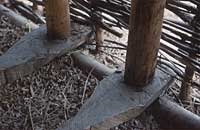- Home
- The house
- Building a Neolithic house
- Other solutions
A number of other architectural solutions were found for setting a house's foundation into wet ground.
At Clairvaux around the 30th century BCE, frameworks of planks placed on the ground supported the piles and kept houses from sinking under their own weight. In another place and time, this same solution was used in Zurich around the 17th century BCE. In northern Italy during the first half of the third millennium, a network of pairs of horizontal long poles laid at right angles intersected with tenons of load-bearing piles.
Frame-based foundations.
Zurich (Switzerland), Pfahlbauland, Early Bronze Age.
Foundations built on horizontal crossed poles.
Fiavé (Trentino, Italy), Middle Bronze Age.
Such foundation systems were probably the successors of the one in which pilings were driven into the soil until they held, coming at a time when the surrounding forest, having been harvested by man, no longer yielded very long, straight poles. The solution chosen involved shallow foundations that made use of shorter pieces of wood, with superstructures made rigid through the use of tenon and mortise joints. Subsequently, each community found its own method of adapting solid-ground architecture to soft, waterlogged soil.


